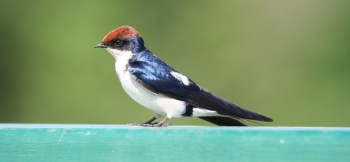- Hirundo smithii
Identification
14cm 14–21 cm (5½-8¼ in)
- Bright blue upperparts
- Flight feathers are darker
- White underparts
- Chestnut crown
- Blue mask through the eye
- White spots on the tail
- Outer tail feather are very long filaments
- At least in Africa, the dark band across the vent area is important for identification
Sexes are similar, but the female has shorter "wires"
Juveniles have a brown crown, back and tail.

Photo © by swiss7
Parfuri, Kruger National Park, South Africa
Distribution
Two distinct populartions Africa (smithii) and Asia (filifera):
Western Africa: Mauritania, Senegambia, Senegal, The Gambia, Guinea-Bissau, Guinea, Mali, Sierra Leone, Ivory Coast, Burkina Faso, Ghana, Togo, Benin, Nigeria, Niger, Chad, Cameroon, Central African Republic, Equatorial Guinea, Gabon, Democratic Republic of Congo, Angola
Eastern Africa: Sudan, Eritrea, Ethiopia, Somalia, Kenya, Uganda, Rwanda, Burundi, Tanzania, Zambia, Mozambique, Malawi
Southern Africa: Namibia, Botswana, Zimbabwe, South Africa, KwaZulu-Natal, eSwatini
Asia: Russia, Uzbekistan, Turkmenistan, Tajikistan, Afghanistan, China, Tibet, Nepal, Pakistan, India, Eastern and Western Himalayas, Bangladesh, Bhutan
Southeast Asia: Indochina, Burma, Laos, Vietnam, Cambodia, Thailand
Taxonomy
Subspecies

Photo © by Alok Tewari
Keoladeo National Park, Bharatpur, India, June-2017
There are 2 subspecies[1]:
- H. s. smithii:
- Widespread Africa south of the Sahara
- H. s. filifera:
- Afghanistan and Baluchistan to India, Myanmar and Indochina
Habitat
Open country near water and human habitation, Marula savannah, open woodland, bushveld, rice fields, marshland
Behaviour
Diet
The diet consists mainly of flying insects.
Breeding
The 3 or four eggs are laid in a half-bowl nest lined with mud. It is fixed to the vertical surfaces of bridges and buildings or under cliff ledges.

Photo © by Alok Tewari
Dist. Mathura, Uttar Pradesh, India, June-2013
Vocalisation
Recording by Alok Tewari
Keoladeo National Park, Bharatpur, India, June-2017
A mixed group of Juvies and adult calling. They were hawking insects over a canal and calling. Background calls by Red-wattled Lapwing and Rose-ringed Parakeet are heard.
References
- Clements, J. F., T. S. Schulenberg, M. J. Iliff, D. Roberson, T. A. Fredericks, B. L. Sullivan, and C. L. Wood. 2017. The eBird/Clements checklist of birds of the world: v2017, with updates to August 2017. Downloaded from http://www.birds.cornell.edu/clementschecklist/download/
- Avibase
- Sinclair et al. 2002. Birds of Southern Africa. Princeton Field Guides, Princeton, New Jersey, USA. ISBN 0-691-09682-1
- NatureTrek
- Wikipedia
- BF Member observations
Recommended Citation
- BirdForum Opus contributors. (2025) Wire-tailed Swallow. In: BirdForum, the forum for wild birds and birding. Retrieved 9 May 2025 from https://www.birdforum.net/opus/Wire-tailed_Swallow
External Links
GSearch checked for 2020 platform.1




